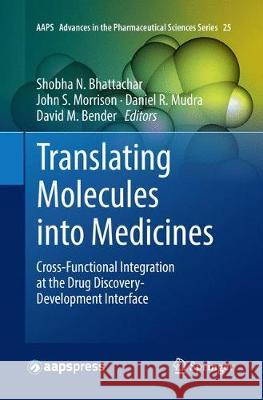Translating Molecules Into Medicines: Cross-Functional Integration at the Drug Discovery-Development Interface » książka



Translating Molecules Into Medicines: Cross-Functional Integration at the Drug Discovery-Development Interface
ISBN-13: 9783319843032 / Angielski / Miękka / 2018 / 461 str.
Translating Molecules Into Medicines: Cross-Functional Integration at the Drug Discovery-Development Interface
ISBN-13: 9783319843032 / Angielski / Miękka / 2018 / 461 str.
(netto: 844,52 VAT: 5%)
Najniższa cena z 30 dni: 880,59 zł
ok. 20 dni roboczych.
Darmowa dostawa!
Pharmaceutical Industry Performance.- Scope: productivity, success rates and costs.- Competitive landscape and regulatory requirements across different geographies. Drivers for increased efficiency, innovative approaches, and outlook for the next decade.- Unmet needs, major therapeutic areas of R&D focus and investment.- New Product Planning: Scope: General overview of patient profiles from different therapeutic areas, competitive intelligence, standard of care considerations, and impact of this information on the definition of NCE and product attributes and timelines.- Discovery Chemistry and Technologies: Scope: The druggable chemistry space, current targets of interest, new discovery technologies to define the binding pockets and compound attributes for a druggable target.- Challenges, examples of innovation and success.- Chemistry (Authors: TBD).- Biology, genomics, target validation.- In silico tools.- Early Discovery: Target of Interest through Lead: Scope: Effective and dynamic cross-functional collaboration between in vitro biology, chemistry, pharmacology, ADME, preformulation and toxicology to achieve Druggable Leads.- Application of in silico, in vitro and in vivo tools and translational approaches and strategies for integrated assessment and creation of druggable and developable lead scaffolds and assessing affinity and druggability at the scaffold level.- FBDD, druggable scaffolds, hit screening and making compounds.- Integrated assessment of Lead readiness, SRA.- Lead Optimization: Scope: Effective and dynamic cross-functional collaboration between in vitro biology, chemistry, pharmacology, ADME, preformulation and toxicology to achieve target engagement with a druggable candidate.- Candidate Selection.- Application of in silico, in vitro and in vivo tools and translational approaches and strategies for integrated assessment and identification of druggable and developable Clinical Candidate(s) with line of sight for clinical development.- Include description of tools, examples of application/case studies.- Developability including formulations and bio-relevant dissolution.- Chemistry scale up.- Early Clinical Development: Scope: Strategies for clinical trial study designs in the context of different therapeutic areas, clinical formulations, safety margins, biomarkers, tailored therapeutics, PK/PD modeling, controlled release formulations.- John Morrison working out the details of this section.- Alternative Drug Delivery: Scope: non-oral formulations based on patient/caregiver/marketing considerations.- Design, definition of compound attributes and development.- Regulatory aspects.- Industry Academia Collaboration.- Outlook for the Future.
Shobha N. Bhattachar is a Director in Small Molecule Design and Development at Eli Lilly and Company. She has a Bachelor’s degree in Pharmacy from Bangalore University, India, and a Master’s degree in Pharmaceutical chemistry from the University of Kansas. Prior to joining Lilly, Bhattachar worked for eight years at Pfizer in Ann Arbor MI, in the Research Formulations group. She has authored/co-authored 15 publications covering wide ranging topics in the field of Pharmaceutical Sciences. Her current interests include the discovery-development interface, clinical candidate selection and developability assessment, clinical formulation development and biopharmaceutical aspects of drug product design.
David M. Bender is a Senior Research Scientist in Small Molecule Design and Development at Eli Lilly and Co. He received a B.S in chemistry from Miami University and an M.S. in organic chemistry from Colorado State University where he conducted research into the design and synthesis of novel antibacterial agents. He joined Eli Lilly and Co. in 1998 as a synthetic organic chemist in Discovery Chemistry Research. In 2009, he joined the Product Research and Development organization, where he has focused on formulation development, small molecule developability, absorption modeling and alternate drug delivery. Mr. Bender is currently a group leader in the Product Design and Developability group, and is responsible for overseeing the design and manufacture of clinical drug product for small molecules entering Lilly’s development pipeline.
Daniel R. Mudra is Director of ADME at Eli Lilly and Company. He earned his B.S. from The University of Dayton studying pharmacokinetic/pharmacodynamic effects of drug-impregnated implants and an M.S. from Loyola University Chicago investigating the biochemical regulation of the p38 kinase pathway. He earned his doctorate in Pharmaceutical Chemistry from The University of Kansas developing in situ and computational models of absorption studying the effects of excipients on permeability, metabolism and transport. Dr. Mudra began his industrial research career at XenoTech, LLC and has published on models of P450 induction and inhibition, drug absorption and PK. Since joining Lilly, he has contributed to projects from target identification to clinical development across a variety of therapeutic areas. He leads in the incorporation of mechanistic and physiologically based PK modeling including the use of molecular attributes to predict human clearance pathways.
Tackling translational medicine with a focus on the drug discovery development-interface, this book integrates approaches and tactics from multiple disciplines, rather than just the pharmaceutical aspect of the field. The authors of each chapter address the paradox between the molecular understanding of diseases, drug discovery, and drug development. Laying out the detailed trends from various fields, different chapters are dedicated to target engagement, toxicological safety assessments, and the compelling relationship of optimizing early clinical studies with design strategies. The book also highlights the importance of balancing the three pillars: sufficient efficacy, acceptable safety and appropriate pharmacokinetics, all of which are crucial to successful efforts in discovery and development. With discussions regarding the combined approaches of molecular research, personalized medicine, pre-clinical and clinical development, as well as targeted therapies—this compendium is a flexible fit, perfect for professionals in the pharmaceutical industry and related academic fields.
1997-2024 DolnySlask.com Agencja Internetowa
KrainaKsiazek.PL - Księgarnia Internetowa









